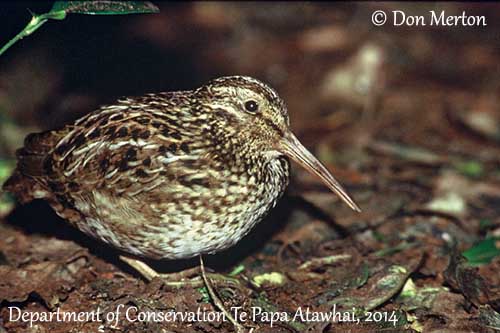
Fr: Bécassine des Chatham
Ang: Chatham Snipe - Chatham Islands Snipe
All: Chathamschnepfe
Esp: Chochita de las Chatham
Ita: Beccaccino delle Chatham
Nd: Chathamsnip
Sd: Chathambeckasin
Photographer:
Don Merton,
Courtesy of Department of Conservation Te Papa Atawhai, 2014
Department of Conservation
Text by Nicole Bouglouan
Sources:
HANDBOOK OF THE BIRDS OF THE WORLD Vol 3 by Josep del Hoyo-Andrew Elliott-Jordi Sargatal - Lynx Edicions - ISBN : 8487334202
BirdLife International (BirdLife International)
New Zealand bird status between 2008 and 2012
Te Ara – The Encyclopedia of New Zealand
Notornis and Birds New Zealand
Chatham Snipe
Coenocorypha pusilla
Charadriiformes Order – Scolopacidae Family
INTRODUCTION:
The Chatham Snipe is fairly similar to the kiwi in some behaviour. It feeds more often in wetland areas than along the shores, and prefers to shelter in the undergrowth rather than in open areas.
This one is the smallest of the New Zealand snipes, and it was first discovered in 1869 on Mangere Island, and in 1974 on the Star Keys. After eradication of introduced cats, and several reintroductions to predator-free islands, the Chatham Snipe has colonized Little Mangere and Rabbit Islands.
However, this species has very small overall range, and remains vulnerable to accidental incursions of predators.
DESCRIPTION OF THE BIRD:
Biometrics:
Length: 20 cm
Wingspan: 28-30 cm
Weight: 80 g
The adult is a compact bird with short legs.
The upperparts are dark rufous-brown with irregular fulvous and black spots, especially on back and scapulars. On these parts, the feathers are edged pale fulvous and show black subterminal spot.
The underparts are paler, and the whitish lower breast and belly show little dark barring. Head sides and breast are heavily spotted rufous-brown, whereas body sides and flanks are more slightly spotted brownish.
On the head, we can see a dark brown line from the bill base to the eye. The crown is striped black, brown and reddish-brown. The supercilium and the cheeks are pale buff.
The long bill (42-48 mm) is greyish-brown with paler base of lower mandible. The eyes are dark brown. Legs and feet are pale yellowish in male.
Both sexes are almost similar, but the female has greenish legs and feet, duller dorsal pattern and slightly larger size.
The juvenile has olive legs and feet. Its plumage is darker with duller pattern overall.

RANGE:
The Chatham Snipe is now found on several islands in the Chatham Island group such as Rangatira, Little Mangere, Rabbit Island and the Star Keys. These islands are predator-free and there, the snipes can be abundant. The species is occasionally seen on Pitt Island.
HABITAT:
The Chatham Snipe usually occurs where it can find dense bush cover, but the species can be seen under open forest among Carex sedges, and sometimes in wet grassy areas in more open habitat. The species is visible from sea-level to the summits of these islands.
CALLS AND SONGS: SOUNDS BY XENO-CANTO
The Chatham Snipe adult male gives loud “chup chup” calls. A threatened bird utters a strident “chep” by day or by night.
The male performing the aerial display “hakawai” utters a series of “queeyoo queeyoo” while in the air at night.
BEHAVIOUR IN THE WILD:
The Chatham Snipe feeds mainly on soil-dwelling invertebrates such as earthworms and amphipods, and also beetles, fly larvae and pupae.
It probes in the leaf litter and moist grassland soils with its long bill, and often swallows the prey before to withdraw the bill from the soil.
It can forage by day or by night in vegetated areas, but more often under forests. It moves quietly on the ground and can be seen alone, in pairs or in family groups according to the season.
But at night, it often ventures in coastal saltmarsh and other more open areas where by day, predators such as Swamp Harrier and skuas could kill them.
The Chatham Snipe pairs are monogamous. The males perform the hakawai aerial display by night, during which the stiff rectrices produce distinct roar sounds. They dive from considerable heights.
The display starts accompanied by series of repeated calls “queeyoo queeyoo” followed by the tail feather’s roar when the bird dives. In addition, the male performs courtship feeding to the female. Once the pair is formed, both mates select a nest-site.
The Chatham Snipe is sedentary, and only some inter-island movements within the Chatham Island group have been observed.
Like other snipes, it has fairly rounded wings designed for navigation among tree limbs. However, it can take-off quickly if threatened.
REPRODUCTION OF THIS SPECIES:
The Chatham Snipe has long breeding season, and eggs can be laid from July to early April.
The nest is on the ground among the vegetation or under grass and sedges. This is a scrape, sometimes lined with leaves or unlined.
The female lays two large brownish eggs with small dark markings. The incubation lasts 19-20 days, shared by both adults. At hatching, the chicks are covered with dark brown down and the plumage pattern is indistinct. They leave the nest very soon after hatching and each parent cares for one chick.
The young are fed during the first 2-3 weeks. They can fly at three weeks old and they are independent 40 days after hatching.
PROTECTION / THREATS / STATUS:
The Chatham Snipe has now fairly stable population, after successful reintroductions to predator-free islands. However, this species remains vulnerable to predation if these refuges are colonized by rats, cats, pigs, or Weka, always present on nearby islands.
The global population is estimated at 1800/2200 mature individuals, equating to 2700/3300 birds in total.
But due to the small overall range, the Chatham Snipe is currently classified as Vulnerable.